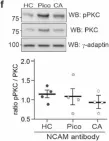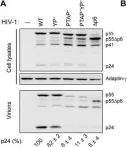Oropouche fever, a debilitating illness common in South America, is caused by Oropouche virus (OROV), an arbovirus. OROV belongs to the Peribunyaviridae family, a large group of RNA viruses. Little is known about the biology of Peribunyaviridae in host cells, especially assembly and egress processes. Our research reveals that the small GTPase Rab27a mediates intracellular transport of OROV induced compartments and viral release from infected cells. We show that Rab27a interacts with OROV glycoproteins and colocalizes with OROV during late phases of the infection cycle. Moreover, Rab27a activity is required for OROV trafficking to the cell periphery and efficient release of infectious particles. Consistently, depleting Rab27a's downstream effector, Myosin Va, or inhibiting actin polymerization also hinders OROV compartments targeting to the cell periphery and infectious viral particle egress. These data indicate that OROV hijacks Rab27a activity for intracellular transport and cell externalization. Understanding these crucial mechanisms of OROV's replication cycle may offer potential targets for therapeutic interventions and aid in controlling the spread of Oropouche fever.
Copyright: © 2024 Concha et al. This is an open access article distributed under the terms of the Creative Commons Attribution License, which permits unrestricted use, distribution, and reproduction in any medium, provided the original author and source are credited.
Product Citations: 33
In PLoS Pathogens on 1 August 2024 by Concha, J. O., Gutierrez, K., et al.
-
Immunology and Microbiology
In IScience on 21 July 2023 by Navarrete-Lopez, P., Maroto, M., et al.
Karyopherins mediate the movement between the nucleus and cytoplasm of specific proteins in diverse cellular processes. Through a loss-of-function approach, we here examine the role of Karyopherin Subunit Alpha 2 (Kpna2) in spermatogenesis. Knockout male mice exhibited reduced body size and sperm motility, increased sperm abnormalities, and led to the dysregulation of testis gene expression and ultimately to infertility. Impaired mRNA expression mainly affected clusters of genes expressed in spermatids and spermatocytes. Downregulated genes included a set of genes that participate in cell adhesion and extracellular matrix (ECM) organization. We detected both the enrichment of some transcription factors that bind to regions around transcription start sites of downregulated genes and the impaired transport of specific factors to the nucleus of spermatid cells. We propose that Kpna2 is essential in the seminiferous tubules for promoting the translocation of testis-specific transcription factors that control the expression of genes related to ECM organization.
© 2023 The Author(s).
-
Mus musculus (House mouse)
-
Biochemistry and Molecular biology
In Molecular Pharmacology on 1 July 2023 by Duarte, M. L., Wang, M., et al.
Current treatments for Alzheimer's disease (AD) help reduce symptoms for a limited time but do not treat the underlying pathology. To identify potential therapeutic targets for AD, an integrative network analysis was previously carried out using 364 human postmortem control, mild cognitive impairment, and AD brains. This analysis identified proline endopeptidase-like protein (PREPL), an understudied protein, as a downregulated protein in late-onset AD patients. In this study we investigate the role of PREPL. Analyses of data from human postmortem samples and PREPL knockdown (KD) cells suggest that PREPL expression modulates pathways associated with protein trafficking, synaptic activities, and lipid metabolism. Furthermore, PREPL KD impairs cell proliferation and modulates the structure of vesicles, levels of neuropeptide-processing enzymes, and secretion of neuropeptides. In addition, decrease in PREPL levels leads to changes in the levels of a number of synaptic proteins as well as changes in the levels of secreted amyloid beta (Aβ) 42 peptide and Tau phosphorylation. Finally, we report that local decrease in PREPL levels in mouse hippocampus attenuates long-term potentiation, suggesting a role in synaptic plasticity. Together, our results indicate that PREPL affects neuronal function by modulating protein trafficking and synaptic function, an important mechanism of AD pathogenesis. SIGNIFICANCE STATEMENT: Integrative network analysis reveals proline endopeptidase-like protein (PREPL) to be downregulated in human sporadic late-onset Alzheimer's disease brains. Down regulation of PREPL leads to increases in amyloid beta secretion, Tau phosphorylation, and decreases in protein trafficking and long-term potentiation.
U.S. Government work not protected by U.S. copyright.
-
Biochemistry and Molecular biology
-
Neuroscience
-
Pharmacology
In Frontiers in Cell and Developmental Biology on 16 December 2022 by Hausrat, T. J., Vogl, C., et al.
Hearing impairment is one of the most common disorders with a global burden and increasing prevalence in an ever-aging population. Previous research has largely focused on peripheral sensory perception, while the brain circuits of auditory processing and integration remain poorly understood. Mutations in the rdx gene, encoding the F-actin binding protein radixin (Rdx), can induce hearing loss in human patients and homozygous depletion of Rdx causes deafness in mice. However, the precise physiological function of Rdx in hearing and auditory information processing is still ill-defined. Here, we investigated consequences of rdx monoallelic loss in the mouse. Unlike the homozygous (-/-) rdx knockout, which is characterized by the degeneration of actin-based stereocilia and subsequent hearing loss, our analysis of heterozygous (+/-) mutants has revealed a different phenotype. Specifically, monoallelic loss of rdx potentiated the startle reflex in response to acoustic stimulation of increasing intensities, suggesting a gain of function relative to wildtype littermates. The monoallelic loss of the rdx gene also facilitated pre-pulse inhibition of the acoustic startle reflex induced by weak auditory pre-pulse stimuli, indicating a modification to the circuit underlying sensorimotor gating of auditory input. However, the auditory brainstem response (ABR)-based hearing thresholds revealed a mild impairment in peripheral sound perception in rdx (+/-) mice, suggesting minor aberration of stereocilia structural integrity. Taken together, our data suggest a critical role of Rdx in the top-down processing and/or integration of auditory signals, and therefore a novel perspective to uncover further Rdx-mediated mechanisms in central auditory information processing.
Copyright © 2022 Hausrat, Vogl, Neef, Schweizer, Yee, Strenzke and Kneussel.
-
WB
-
Mus musculus (House mouse)
-
Cell Biology
In Cellular and Molecular Life Sciences : CMLS on 29 October 2022 by Radwitz, J., Hausrat, T. J., et al.
Microtubules are dynamic polymers of α/β-tubulin. They regulate cell structure, cell division, cell migration, and intracellular transport. However, functional contributions of individual tubulin isotypes are incompletely understood. The neuron-specific β-tubulin Tubb3 displays highest expression around early postnatal periods characterized by exuberant synaptogenesis. Although Tubb3 mutations are associated with neuronal disease, including abnormal inhibitory transmission and seizure activity in patients, molecular consequences of altered Tubb3 levels are largely unknown. Likewise, it is unclear whether neuronal activity triggers Tubb3 expression changes in neurons. In this study, we initially asked whether chemical protocols to induce long-term potentiation (cLTP) affect microtubule growth and the expression of individual tubulin isotypes. We found that growing microtubules and Tubb3 expression are sensitive to changes in neuronal activity and asked for consequences of Tubb3 downregulation in neurons. Our data revealed that reduced Tubb3 levels accelerated microtubule growth in axons and dendrites. Remarkably, Tubb3 knockdown induced a specific upregulation of Tubb4 gene expression, without changing other tubulin isotypes. We further found that Tubb3 downregulation reduces tubulin polyglutamylation, increases KIF5C motility and boosts the transport of its synaptic cargo N-Cadherin, which is known to regulate synaptogenesis and long-term potentiation. Due to the large number of tubulin isotypes, we developed and applied a computational model based on a Monte Carlo simulation to understand consequences of tubulin expression changes in silico. Together, our data suggest a feedback mechanism with neuronal activity regulating tubulin expression and consequently microtubule dynamics underlying the delivery of synaptic cargoes.
© 2022. The Author(s).
-
WB
-
Biochemistry and Molecular biology
In Int J Mol Sci on 2 September 2022 by Amores-Bonet, L., Kleene, R., et al.
Fig.10.F

-
WB
-
Collected and cropped from Int J Mol Sci by CiteAb, provided under a CC-BY license
Image 1 of 3
In Cells on 26 October 2021 by Sousa, D., Lima, R. T., et al.
Fig.1.B

-
WB
-
Collected and cropped from Cells by CiteAb, provided under a CC-BY license
Image 1 of 3
In BMC Biol on 23 June 2016 by Nkwe, D. O., Pelchen-Matthews, A., et al.
Fig.1.A

-
WB
-
Homo sapiens (Human)
Collected and cropped from BMC Biol by CiteAb, provided under a CC-BY license
Image 1 of 3


